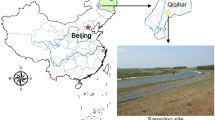Abstract
The time-dependent settlement of soft soil poses serious maintenance problems to developments along coastal and riverside areas that encounter thick, soft soil deposits. To overcome this problem, therefore, a lightweight material called Air-Trapped Soil (ATS) was developed. ATS was prepared using sand produced at a factory, so its quality is highly stable. To determine the characteristics of the developed ATSs, a series of unconfined compressive and split tensile tests were conducted, and the compressive and tensile strength characteristics of the lightweight ATSs of various combinations of cement-air bubble-sand were determined. In addition, the relationship between the compressive and tensile strengths was determined. This result shows that the mechanical strength characteristics of the ATS significantly depend on the quantity of air bubbles in the ATSs.







Similar content being viewed by others
References
ASTM C 495 (2012) Standard test method for compressive strength of lightweight insulating concrete
Chang MS, Chun BS, Lim HS (1996) A study on engineering characteristics of load reducing material EPS. J Korean Geotech Soc 12(2):59–69
EPS Civil Method Development Consortium (1993) EPS method, Rikou Tosho Co., Tokyo, pp 1–58
Gan CH, Tan SM (2003) Some construction experiences on soft soil using light weight materials. In: 2nd international Conference on Advances in Soft Soil Engineering and Technology, Putrajaya, Malaysia
Hayashi Y, Suzuji A, Matsuo A (2002) Mechanical properties of air-cement-treated soils. Ground Improv 6(1):69–78
Highgrade Soil Research Consortium (2005) Technical data for construction method of air-mixed soil, Technical report, p 158
Hong SW (1994) The engineering characteristics of expanded polystyrene. In: International Symposium on the Application of EPS foam for embankment Construction, Seoul, pp 53–80
Im JC, Jang JK, Lee SW (2007) Application of lightweight foam mixed soil method. In: Proceedings of Autumn Conference of Korean Geotechnical Society, pp 679–691
Jamnongpipatkul P, Dechasakulsom M, Sukolrat J (2009) Application of air foam stabilized soil for bridge-embankment transition zone in Thailand. Geotechnical Special Publication No. 190, pp 181–193
Japanese Highway Public Corporation (1996) Design and construction guidelines of foamed cement banking method using foamed mixture light-weight soil. Technical document No. 225, pp. 61
Kim ZC, Lee CK (2002) Mechanical characteristics of light-weighted foamed soil consisting of dredged soils. J Korean Geotech Soc 18(4):309–317
Kim YT, Ahn J, Han WJ, Gabr MA (2010) Experimental evaluation of strength characteristics of stabilized dredged soil. J Mater Civ Eng 22(5):539–545
Korean Standards (KS) F 4039 (2006) Standard Specification for foamed concrete for cast-in-site
Miki H, Mori M, Chida S (2003) Trial Embankment on soft ground using lightweight-foam-mixed in situ surface soil. In: Proceedings of XXIInd PIARC World Road Congress, Durban
Namikawa T, Kosek J (2007) Evaluation of tensile strength of cement-treated sand based on several types of laboratory tests. Soils Found 47(4):657–684
Raad L, Monismith CL, Mitchell JK (1977) Tensile-strength determinations of cement-treated materials. Transp Res Rec 641:48–52
Song JH (2009) Analysis of compressive strength of lightweight air-mixed soil according to the properties of soil. Dissertation, Pusan National University
Song JH, Im JC, Hong SW (2008) Analysis of compressive strength of lightweight air-mixed soil according to the properties of soil. J Korean Geotech Soc 24(11):1–10
Tsuchida T, Takeuchi D, Okumura T, Kishida T (1996) Development of lightweight fill from dredgings. In: Proceedings of Environmental Geotechnics, Balkema, pp 415–420
Watabe Y, Tanaka M, Sassa S (2009) 10-year follow-up study on long-term properties of air-foam treated lightweight soil placed in coastal areas, PARI Report 048-02-07, vol 48(2)
Yajima J, Mydin SH (2006) Mechanical properties of the unsaturated foam composite light-weight soil. Geotech Special Publ 147:1639–1650
Yoon GL, Kim BT (2004) Compressibility and strength characteristics of light-weighted foam soil. J Korean Geotech Soc 20(4):5–13
Yoon GL, You SK (2004) Strength and deformation characteristics of lightweight foamed soil using in-situ Soil. J Korean Geotech Soc 20(9):125–131
Acknowledgments
This research was financially supported by the Ministry of Education, Science Technology (MEST) and the Korea Institute for Advancement of Technology (KIAT) through the Human Resource Training Project for Regional Innovation.
Author information
Authors and Affiliations
Corresponding author
Rights and permissions
About this article
Cite this article
Kim, TH., Kang, GC. & Park, LK. Development and mechanical strength properties of a new lightweight soil. Environ Earth Sci 72, 1109–1116 (2014). https://doi.org/10.1007/s12665-013-3027-2
Received:
Accepted:
Published:
Issue Date:
DOI: https://doi.org/10.1007/s12665-013-3027-2




